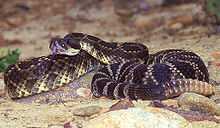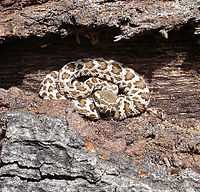Crotalus oreganus helleri
| Crotalus oreganus helleri | |
|---|---|
 | |
| Scientific classification | |
| Kingdom: | Animalia |
| Phylum: | Chordata |
| Subphylum: | Vertebrata |
| Class: | Reptilia |
| Order: | Squamata |
| Suborder: | Serpentes |
| Family: | Viperidae |
| Subfamily: | Crotalinae |
| Genus: | Crotalus |
| Species: | C. oreganus |
| Subspecies: | C. o. helleri |
| Trinomial name | |
| Crotalus oreganus helleri Meek, 1905 | |
| Synonyms | |
Crotalus oreganus helleri is a venomous pitviper subspecies[3] found in southwestern California and south into Baja California, Mexico.
Etymology
The specific name, helleri, is in honor of American zoologist Edmund Heller.[5]
Description
Adults are 24-55 inches (61-139 cm) in length.[4]

The color pattern consists of a pale brown, gray-brown, or yellowish brown ground color overlaid with a series of large, dark brown dorsal blotches that may or may not have pale centers.[6] The blotches are more diamond shaped, as opposed to those of C. o. oreganus that are more hexagonal,[4] and are bordered by light scales. The tail rings are not clearly defined.[7] In juveniles, the end of the tail is bright orange, but this turns to brown as the snakes mature. In adults, the base of the tail and the first segment of the rattle are brown. The postocular stripe is moderately to very clearly defined. In juveniles, this stripe is bordered above by a pale stripe, but as the snakes mature this turns to drab yellow or brown. A conspicuous pale crossbar is sometimes present across the supraoculars, after which the head is a uniform dark color. In some older snakes the head is mostly dark with almost no trace of the supraorbital crossbar, or none at all.[6]
Common names
Southern Pacific rattlesnake,[3][4] black diamond rattlesnake, black (diamond) rattler, gray diamond-back, mountain rattler, Pacific rattler, San Diegan rattler.[4] and Green rattlesnake
Venom
Crotalus oreganus helleri has a highly toxic venom that is much like mojave toxin in the way it attacks nerve endings. It also contains myotoxins and hemotoxins and can easily give a fatal bite.[8] The venom from this snake also requires a much higher dose of Crofab, an antivenin used to treat the bite of North American pit-vipers.[9]
Geographic range

The United States in southern California, and Mexico in northern Baja California, west of the desert. In the north from the counties of San Luis Obispo and Kern, and south through the counties of Santa Barbara, Ventura, Los Angeles (including Santa Catalina Island), southwestern San Bernardino, Orange, western Riverside, San Diego and extreme western Imperial. From there its range extends south through Baja California to lat. 28° 30' North.[10] According to Klauber (1956), the type locality is "San Jose, Lower California" [San José, lat. 31° N, Baja California (state), Mexico].[1]
See also
- List of crotaline species and subspecies
- Crotalus by common name
- Crotalus by taxonomic synonyms
- Crotalinae by common name
- Crotalinae by taxonomic synonyms
- Snakebite
References
- ↑ 1.0 1.1 McDiarmid RW, Campbell JA, Touré T. 1999. Snake Species of the World: A Taxonomic and Geographic Reference, vol. 1. Herpetologists' League. 511 pp. ISBN 1-893777-00-6 (series). ISBN 1-893777-01-4 (volume).
- ↑ The Reptile Database. www.reptile-database.org.
- ↑ 3.0 3.1 3.2 "Crotalus oreganus helleri". Integrated Taxonomic Information System. Retrieved 28 November 2006.
- ↑ 4.0 4.1 4.2 4.3 4.4 Wright AH, Wright AA. 1957. Handbook of Snakes. Comstock Publishing Associates. (7th printing, 1985). 1105 pp. ISBN 0-8014-0463-0.
- ↑ Beltz, Ellin. 2006. Scientific and Common Names of the Reptiles and Amphibians of North America – Explained. ebeltz.net/herps/biogappx/html.
- ↑ 6.0 6.1 Campbell JA, Lamar WW. 2004. The Venomous Reptiles of the Western Hemisphere. 2 volumes. Comstock Publishing Associates, Ithaca and London. 870 pp. 1500 plates. ISBN 0-8014-4141-2.
- ↑ Behler JL, King FW. 1979. The Audubon Society Field Guide to North American Reptiles and Amphibians. New York: Alfred A. Knopf. 743 pp. LCCCN 79-2217. ISBN 0-394-50824-6.
- ↑ http://www.kingsnake.com/toxinology/old/snakes/American/rattlesnake.html
- ↑ http://www.savagelabs.com/Products/CroFab/Home/crofab_frame.htm Link to PDF for full prescribing information, retrieved 11/11/12
- ↑ Klauber LM. 1997. Rattlesnakes: Their Habitats, Life Histories, and Influence on Mankind. Second Edition. First published in 1956, 1972. University of California Press, Berkeley. ISBN 0-520-21056-5.
Further reading
- Ashton KG, de Queiroz A. 2001. Molecular systematics of the western rattlesnake, Crotalus viridis (Viperidae), with comments on the utility of the d-loop in phylogenetic studies of snakes. Molecular Phylogenetics and Evolution, Vol. 21, No.2, pp. 176-189. PDF at CNAH. Accessed 12 December 2007.
- Hubbs B, O'Connor B. 2012. A Guide to the Rattlesnakes and other Venomous Serpents of the United States. Tricolor Books. Tempe, Arizona. 129 pp. ISBN 978-0-9754641-3-7. (Crotalus oreganus helleri, pp. 25-27.)
- Meek, SE. 1905. An Annotated list of a Collection of Reptiles from Southern California and Northern Lower California. Field Columbian Museum Publication 104. Zoological Series, Vol. 7, No. 1, pp. 1-19. ("Crotalus helleri sp. nov.", pp. 17-18 & Plate II.)
External links
| Wikimedia Commons has media related to Crotalus oreganus. |
- Crotalus oreganus at the Reptarium.cz Reptile Database. Accessed 12 December 2007.